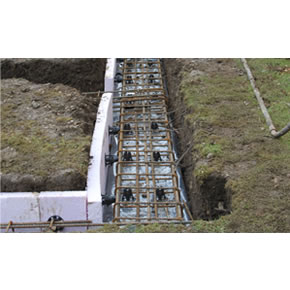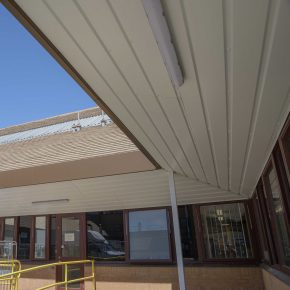
How to choose the right foundation for homebuilding
Since there are many different types of foundation on the market, it is important for property builders to identify the best solution before committing to one. Geobond has outlined several options for consideration.
When building a property or an extension, variables such as wind speed, soft ground and the closeness of drains or trees can affect what type of foundation you should use to build on.
Geobond has stressed the importance of choosing the right type for a successful project.
Strip foundation
Strip foundation is perhaps the most commonly used foundation to build properties throughout the UK.
Trenches must be dug to at least 150mm; they are then filled with concrete to create a border around the area of the property. The distance from the front face of the wall to the edge of the foundation should be equal to the depth of the foundation, providing it exceeds 150mm.
When laying a strip foundation, it is important to consider the proximity of foliage; the moisture used by trees, for example, will cause the ground to rise and fall. Chopping the tree down will encourage the ground to swell, affecting the drainage of the property.
Trench fill foundation
In comparison to strip foundation, trench fill foundation is thinner in size but thicker in concrete. Best used in chalk soils and clay, it is often preferred by self-builders.
Trench fill foundation must be used on stable ground to ensure that the home is adequately supported; as a high amount of concrete is required to fill the trench, there is no need to use bricks below the surface.
Engineered foundation
Engineered foundations often require a structural engineer to advise the best solution.
The most common engineered foundation involves building deeper trenches, filling them with more concrete and laying polystyrene sheets to help to prevent slipping.
If the trenches need to be dug deeper than 2.5m, a different kind of foundation will be required. Piling, for example, is particularly useful when building on water or damp soil. It involves building piles vertically into the ground and filling them with concrete; the foundation can then be laid.
Rafts can also be used as an alternative if the land is prone to flooding: a concrete raft, which is designed to float on the ground, will act as the foundation for the property.
Engineered foundation can be an expensive and time consuming option, but it is ideal for building on difficult ground.
Latest news

26th April 2024
Alumasc Skyline and Rainwater package specified at Weston-super-Mare Hospital
A package of products from Alumasc Water Management Solutions (AWMS) has been used for the external refurbishment of the roofline at Weston General Hospital in Weston-Super-Mare.
Posted in Aluminium Products, Articles, Building Industry News, Building Products & Structures, Building Services, Building Systems, Case Studies, Cladding, Drainage Services, Drainage, Guttering, Soffits & Fascias, Fascias, Restoration & Refurbishment, Retrofit & Renovation, Roofs, Walls
26th April 2024
Hush Acoustics optimises fleet operations by securing FORS Gold accreditation
Hush Acoustics has invested in the safety and sustainability of its commercial vehicle fleet by achieving Gold status in the Fleet Operator Recognition Scheme (FORS).
Posted in Acoustics, Noise & Vibration Control, Articles, Building Industry News, Building Products & Structures, Building Regulations & Accreditations, Building Services, Ceilings, Facility Management & Building Services, Floors, Health & Safety, Insulation, Restoration & Refurbishment, Retrofit & Renovation, Site Preparation, Sustainability & Energy Efficiency, Walls, Waste Management & Recycling
26th April 2024
Safeguard Europe: Penetrating damp - how to diagnose the damage
As Safeguard gets ready to deliver another informative session of one of its most popular webinars, the company outlines some of the most common reasons for rain penetration through brickwork.
Posted in Articles, Bricks & Blocks, Building Industry Events, Building Industry News, Building Products & Structures, Building Services, Continuing Professional Development (CPD's), Damp & Waterproofing, Facility Management & Building Services, Information Technology, Posts, Render, Restoration & Refurbishment, Retrofit & Renovation, Seminars, Training, Walls
25th April 2024
ADSA: Competence Initiative Makes Progress
The Joint Competency Initiative (JCI), in which the Automatic Door Suppliers Association (ADSA) is involved, is finalising its first framework for installers within the door, gates and shutter industry.
Posted in Access Control & Door Entry Systems, Architectural Ironmongery, Articles, Building Associations & Institutes, Building Industry Events, Building Industry News, Building Products & Structures, Building Regulations & Accreditations, Building Services, Continuing Professional Development (CPD's), Doors, Facility Management & Building Services, Health & Safety, Innovations & New Products, Publications, Research & Materials Testing, Restoration & Refurbishment, Retrofit & Renovation, Security and Fire Protection, Site Preparation
 Sign up:
Sign up: